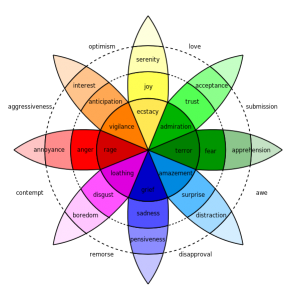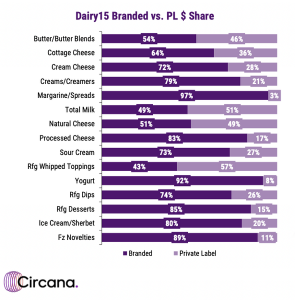Data, data, data – the more you have, the better!
And there’s no better way to get immediate, actionable insights for your site than to use A/B testing.
What Is A/B Testing?
A/B testing, also called split testing, presents two slightly different versions of a given page to a random selection of your website viewers.
In general, one version of the page is the control, and the other has a small but meaningful tweak – for example, a different headline.
Benefits of A/B Testing
By putting versions head to head, you can quickly determine which one is the most effective, but there’s so much more to be gained from testing.
Bounce Rates Reduce.
No one wants to see a dramatic bounce off of a page that they’ve put a lot of time and effort into creating. But, if that’s the case, optimizing the page is your best bet to reducing that rate.
A/B testing can help by letting you monitor which updated version of the page is going to earn more engagement, and therefore be less likely to have visitors bounce.
Conversion Rates Increase.
Simultaneously, if your bounce rate decreases, typically you’ll see your conversions increase. You’ve heard the saying, “Give the people what they want?”
Well, the best way to learn what they want is through experimentation and analysis. An A/B test will highlight what your audience likes. Once you make the necessary changes, you should see a spike in conversions since you’re delivering the value that they’re looking for.
Identifying Opportunities Is Easier.
When you leverage other tools, like heatmaps, with A/B testing, you’ll be able to get a pretty clear picture of what’s working and what isn’t.
Optimization is critical to the livelihood of any project you may develop. The market and consumer interests are in a constant state of evolution. If you’re not working to keep up, then not only will you fall behind, but you’ll never catch up.
A/B tests are a great way to get a sense of what your customers are fans of at the time and will clue you in on where you can improve.
There’s Lower Risk Involved.
Big redesigns and other major revisions cost time and resources, so it’s usually wise to approach a strategy change with a bit of caution and a lot of planning.
With A/B testing, you can minimize the risk of investing in a huge overhaul that’s doomed to fail by paying attention to visitor behavior and engagement metrics. You’ll be able to target the right elements to update for maximum impact.
Think of it as a trial period. It’s always a good idea to take advantage of a free trial before making the decision to purchase a product you’ve never used before.
What Should You A/B Test on Your Website?
Technically, you can play with pretty much anything with A/B testing.
From fonts to color palettes and image size to video length, it’s always fun to experiment and try new things. If you’ve got ideas, it’s always safest to try them in a controlled environment first.
That being said, there are definitely specific elements you’ll want to A/B test if you’re looking for strong results for your business.
Whether you’re trying to lengthen user session times or increase survey engagements, here are are the most common website elements to test that have a direct impact on ROI:
- Forms
- CTA buttons
- Overall website design/concept
- Web copy
- Product info and images
- Popups
- Email marketing templates
- Email subject lines
All of these elements influence your sales and revenue, so it’s always a good idea to run an A/B test to make sure that they’re going to yield positive results for your business.
Make sure that you’re only testing one variable at a time when looking for results. Testing multiple variables at one time can lead to confusing, skewed numbers and slow down the optimization of your webpage.
7 of the Best A/B Testing Tools
As with anything in digital marketing, there’s no one perfect tool that will work for everyone. In general, though, A/B testing tools represent one area where you want to simplify the technology stack as much as possible.
Different tools may give slightly different outputs under the same conditions, so it’s generally not advisable to run them side by side like you can with other apps.
1. Google Analytics
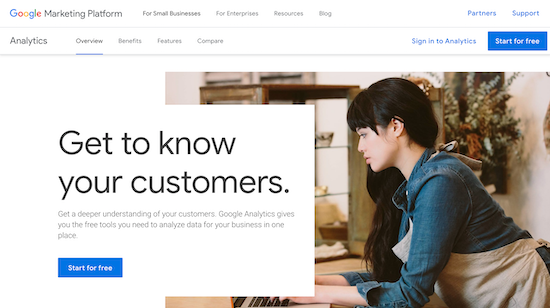
Google Analytics stands apart as the best analytics suite on the web for two good reasons: First, it’s supported by the biggest name on the internet. And second, it’s free.
What many people don’t know (thanks to Google Analytics’ notoriously clunky interface) is that it can handle A/B testing.
You can find Google Analytics’ A/B testing tools under the “Content Experiments” menu. Even though it has robust features and deep reporting, however, it is hampered by the lack of a visual interface. It can take a while to get a handle on Google Analytics, but it is worth it.
2. Optimizely
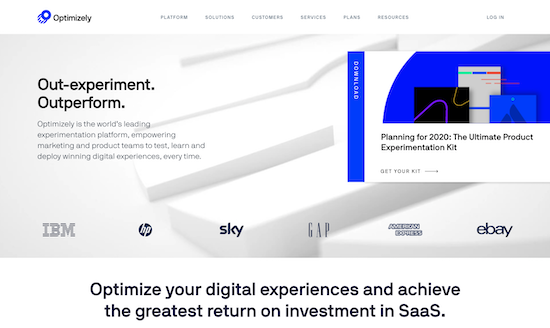
If you find GA’s interface impenetrable but you want to get started and see the difference that split testing can make, Optimizely is a good “plan B.” It delivers on an easy WYSIWYG interface. Digital marketing experts can pick it up in just a day.
In addition to conventional A/B testing, Optimizely also offers multivariate and mobile testing. This makes it more attractive than the simpler options out there, especially if you are pushing for a premium mobile experience. It gives you room to grow into advanced features as you learn.
3. Visual Website Optimizer (VWO)
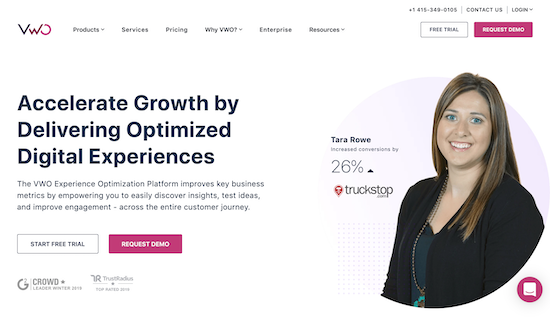
At first, VWO might feel just like Optimizely. However, there are some vital differences just under the surface.
Like Optimizely, it brings you a straightforward, visually-focused interface that’s a pleasure to use, but it also rolls in a number of other tests you may be doing anyway.
VWO’s built-in heatmaps allow you to get a clearer idea of what’s really happening on your page, as you’ll be able to track user attention and mouse movements. There’s also built-in testing for usability and conversion tracking, helping you keep things centralized.
4. Unbounce
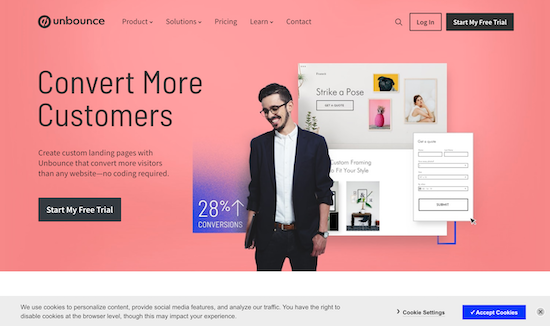
Unbounce has gotten pretty famous in certain corners of the digital marketing world thanks to its relentless focus on landing pages. After all, your A/B testing efforts should focus on your most important landing pages, especially at the beginning.
Unbounce is a great option if you want some inspiration for creating your landing pages. Each account comes with plenty of page templates and easy integration for the most popular marketing suites out there. It’s quick, effective, and provides actionable intelligence.
5. KISSmetrics
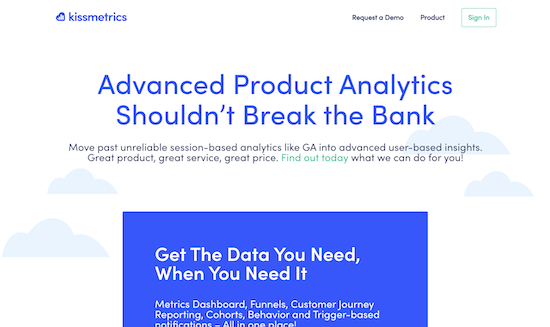
KISSmetrics is one of the more pricey options out there, but it has a novel premise.
It enables its own testing and tracking based on distinct user sessions, allowing you to monitor individuals as they interact with your site. This gives you insights across the conversion funnel.
If you are in the market for a tool that will help you optimize your entire funnel, then KISSmetrics is worth a look. It has more reporting options than many of the alternatives, so it could be a breakout way to translate your results for clients or non-technical executives.
6. Crazy Egg
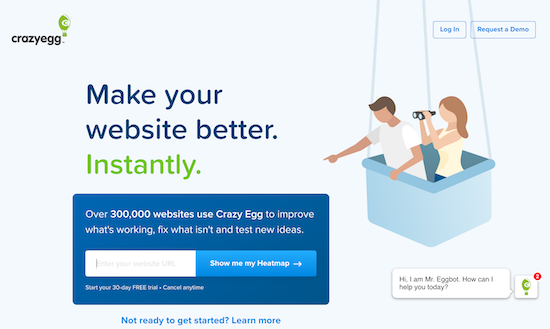
Crazy Egg prides itself on a visually-focused approach that helps you understand exactly what you’re seeing at a glance.
It comes with six different reporting styles and is intended to be the easiest to learn and use. Aficionados say that it can even be fun.
Crazy Egg can be a comfortable way for non-specialists to grasp what’s going on without having to learn the ins and outs of data analytics. It’s also a cost-effective option that will fit most budgets. That said, it doesn’t have the depth or versatility of the more robust options out there.
7. Five Second Test
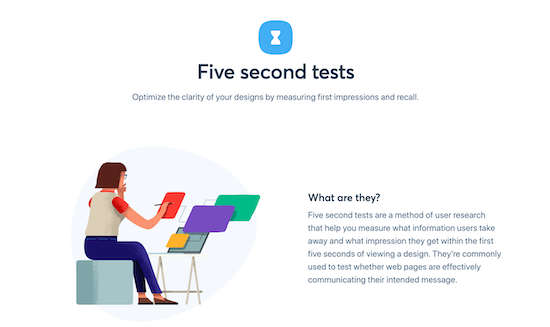
Five Second Test is one of the rare A/B testing tools that really dives in and focuses like a laser on the most important elements.
Not all aspects of your page are likely to produce noticeable results when split tested, so this tool zooms in on elements that change users’ first impressions.
With three tests to choose from and reporting that gets right down to the nitty gritty, Five Second Test gives you what matters. You’ll discover things like what users are most likely to remember from your page and which elements are easy to navigate.
What to Do After You A/B Test
Once you’ve run your test for an appropriate amount of time, you’ll want to take the data you’ve collected and measure the significance of your results against your primary goal.
Remember, you’re going to be looking at a lot of metrics, but your goal should always be at top of mind.
Calculate the number of tries for every variation against your goals, which generally is represented by some conversion type. Identifying the statistical significance will help you identify what worked and what didn’t.
From there, it’s time to turn those numbers into an actionable strategy.
Disable the losing variation and focus your efforts on refining and preparing the version that yielded favorable results. Not only will the A/B test help on a case by case basis, the results can be applied to future strategies as well.
A/B Testing Tools Help You Get Conversions When it Counts
Your whole traffic strategy boils down to this: When people get to your landing pages, how do they react?
Unless you can get that all-important first conversion, visitors might never stick around long enough to enjoy your carefully crafted content and brand message.
Conversion optimization can be frustrating, especially when you don’t have enough data to really get a peek into your viewers’ heads. With the right A/B testing tools, the mystery is solved – at least to some extent – and you can start making measurable progress.
Depending on your current traffic, you may be able to run different tests every day, every week, or every few weeks.
Whatever the case, A/B testing is like hitting the gym. You may not notice much at first, but you can build on your momentum with consistent effort.
To speed things up, enact best practices in landing page design and copy.
A/B testing is one of the little things that really matter – it can be the difference between success and failure. Hang in there and soon, you’ll see the results.
Digital & Social Articles on Business 2 Community
(47)
Report Post


